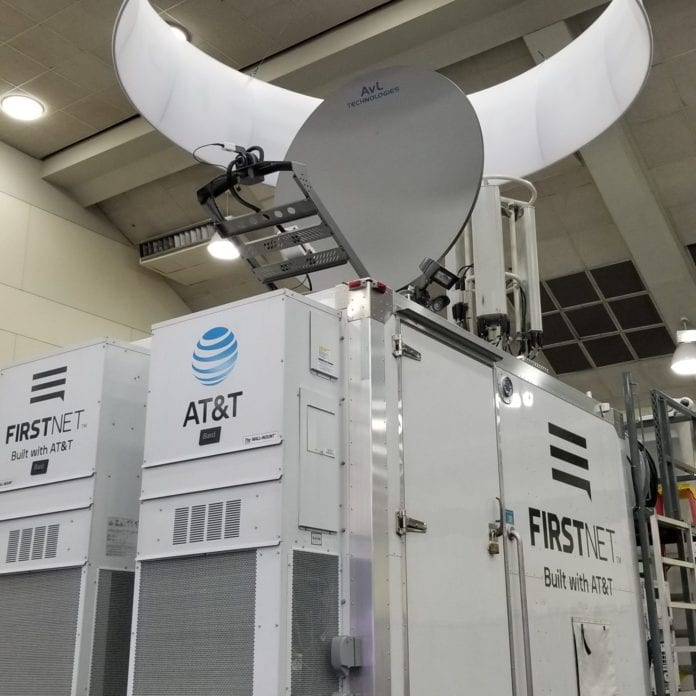AT&T says it added nearly 100,000 square miles to FirstNet’s coverage footprint in 2020
FirstNet-AT&T says that the network is supporting more than 2 million connections across the country, with more than 15,000 agencies and organizations as its customers. AT&T said that it has surpassed 90% of its Band 14 coverage target for FirstNet and that it is “well ahead of schedule.”
The carrier also said that it is going beyond its initial build commitment with the FirstNet Authority, enabling Band 14 on both new and existing AT&T cell sites to reach “several hundred thousand additional square miles.” AT&T said that this was, in part, an effort to bridge the digital divide for both first responders and its regular customers in rural and hard-to-reach areas, who can
The initial plans for FirstNet expansion in rural, remote and tribal areas included plans for more than 1,000 new sites, and AT&T says that more than half of those sites are complete. It also said that it’s working with rural network providers to “more quickly address rural coverage needs and expand the reach” of the FirstNet-AT&T network
“These are major milestones in the growth, adoption and deployment of public safety’s network,” said Ed Parkinson, CEO of the FirstNet Authority. He added that the authority “is pleased that buildout continues to be ahead of schedule and that we are moving closer to fully realizing the vision of a nationwide network that serves all of public safety. This progress shows the strength of our partnership with public safety and how their involvement is critical to the success of the network.”
The carrier framed its build-out in rural and hard-to-reach places as one that will not only bridge the urban-rural digital divide for first responders (and enable them to use High-Powered User Equipment that extends the reach of the network), but will serve AT&T’s non-FirstNet customers in those locations better as well, because those customers can access Band 14 when there is extra capacity not in use by FirstNet users.
Kevin Killer, president of the Oglala Sioux Tribe, said in a statement that FirstNet is “building out critical broadband infrastructure in areas that have long been underserved.” The Oglala Sioux Tribe’s law enforcement department was a FirstNet early adopter, and Killer said that a new FirstNet cell tower east of Vetal, South Dakota “has improved connectivity for our first responders on FirstNet and the broader community.”
With network resiliency an even more important factor amid the ongoing global pandemic and recent events such as the bombing in downtown Nashville that impacted AT&T’s network and the widespread, extended power outages in Texas due to frigid weather, AT&T said that it is also bolstering its backup power resources for sites. While FirstNet-AT&T said that 98% of the population is covered by cell sites with permanent backup power solutions, the carrier said that as it builds new cell sites, it is including fixed generators “whenever possible and are committed to growing our fixed generator support on existing infrastructure.” In locations where a permanent backup generator isn’t possible, FirstNet-AT&T added, its FirstNet Response Operations and AT&T Network Disaster Recovery teams step in to make sure that extended batteries and portable generators are available as needed.
In addition, FirstNet-AT&T also said that it has seen “tremendous interest and use” of its fleet of more than 80 deployables, with more than 750 requests in 2020 for the deployables to bolster coverage for planned or emergency events. The carrier also said that it has provided the U.S. territory of Puerto Rico with dedicated portable cell sites on-island.
Among the latest high-profile agencies to sign on as FirstNet customers is the Los Angeles Police Department, which is equipping thousands of its employees with FirstNet access; the city of Cambridge, Massachusetts will equip its police, fire, EMS and other first responders with FirstNet devices as well.
Deputy Chief John McMahon, who is commanding officer for LAPD’s information technology bureau, said in a statement that the FirstNet team’s “demonstrated flexibility and willingness to adapt has become a critical aspect in the advancement of the LAPD’s mobility strategy and the management of our information technology infrastructure – critical for the thousands of officers that are dedicated to protecting and serving the people of Los Angeles.”

